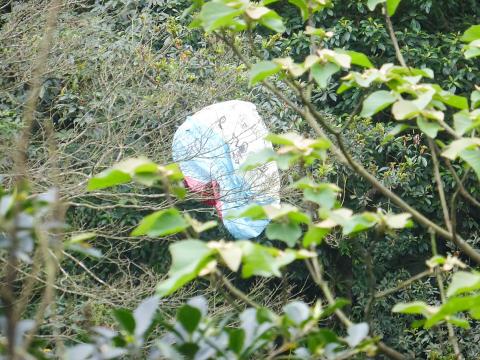A photo of a dead owl tangled in a sky lantern has resurfaced on the Internet in recent years every time the Lunar New Year approaches. Even though the photo is neither recent nor was it taken in Taiwan, it’s still one of the more visible symbols surrounding the debate that ignites every year surrounding the Pingsi Sky Lantern Festival.
Watching hundreds of brightly-colored sky lanterns rise from the crowd, blanket the sky and disappear into the night is probably one of the more spectacular sights you can see in Taiwan, and the festival has been gaining global recognition, being frequently named as a must-travel destination in various prestigious publications.
“Pingsi’s sky lanterns have transformed from a local folk activity into an internationally important festival,” Eric Chu (朱立倫), New Taipei City mayor said last year.

Photo: Lin Hsin-han, Taipei Times
But the lanterns surely don’t just disappear into the sky. There’s no denying the festival’s cultural value and economic impact, but many citizens have been calling to boycott the event due to its impact on the ecosystem as the lanterns fall and scatter in the wilderness and possibly onto residences.
The arguments are similar each year: It’s a fire hazard, it creates litter, the kerosene pollutes the soil and rivers while animals may accidentally ingest the debris along with its metal wires or become tangled, like the owl in the photo.
BANNED LANTERNS

Photo courtesy of the New Taipei City Government’s Tourism and Travel Department
Almost all counties and cities in Taiwan have banned the use of sky lanterns — but, like Tainan’s ordinance, for example, some exceptions are allowed during traditional events. The designated area in Pingsi Township, New Taipei City, is the only place where it’s legal to set off lanterns year round from 6am to 10pm.
This year the debate was ignited by several Internet posts, including one by animal rights organization Wuo Wuo (窩窩), which, incidentally, used the photo of the dead owl. The post states that in the old days, the lanterns weren’t as big as they are now and were constructed with biodegradable bamboo and paper. Today, to save money and time, they are often made with metal wire and even plastic components.
An unlikely proponent for boycotting the festival was technology entrepreneur Ben Jai (翟本喬), who posted on his Facebook that if people wanted to set off sky lanterns they should unfriend him first.
A wave of comments followed, with some supporting him and others disagreeing, including one Pingsi resident who claims that her family was able to make a living off of the sky lanterns.
Another post that went viral was a video, A Truth We’re Unwilling to Face (不願面對的真相), filmed on Jan. 1 by avid biker Eddie Chen (陳忠利), who often visits the area. It shows sky lanterns falling into the green mountains
“Look closely, the white dots in the mountains are not flowers, they’re the garbage produced after you make your wish,” a caption reads.
Much of the discussion around Chen’s video centered on the fact that even though the festival only takes place over the course of a few weeks once per year, people are still allowed to set off lanterns in Pingsi every day as opposed to other cultural events such as the Yenshui Beehive Fireworks Festival in Tainan. They claim that it’s no longer a traditional activity and has become a means of profit.
Huang Jui-fen (黃瑞芬), a concerned citizen who says she has done extensive research on the issue, recently wrote a letter to the New Taipei City government urging them to stop organizing the festival and ban all uses of sky lanterns. She says that the lantern festival was never a tradition — people used them in the late 1800s for communication purposes and the festivities didn’t begin until the 1990s.
“They were never used for wishing good luck and were never released on such a massive scale,” she says. “This is businessmen and the government working together to make money in the name of tradition. It’s a public hazard and the government is the one leading the public in doing such a thing.”
Huang received a rather generic reply from the government, more concise but similar than what they sent the Taipei Times below.
GOVERNMENT RESPONSE
New Taipei City’s tourism and travel department provided the Taipei Times with sky lantern regulations — which do not mention what material the lanterns should be made of, though it specifies the amount of fuel (kerosene-soaked paper) each lantern is allowed to contain so they don’t fly too high or far.
The standard modern design, detailed in a 2009 paper from Chaoyang University of Technology as well as other sources, show that metal wires are an essential component.
The department states that surrounded by mountains on all sides, Pingsi’s landscape provides a natural barrier for the lanterns, which can rise up to between 600m and 800m and travel within a 5km radius, so they remain and fall in the area, making it “very safe.” This does not address the lanterns’ impact on Pingsi itself, which is what public concern appears to be about.
The city has also implemented a recycling program, where residents can turn in lantern frames and paper for money, giving them incentive to help with the cleaning effort. However, the 31,890 lantern papers recycled in 2015 are just a fraction of the total amount of lanterns set off per year — estimates vary between 300,000 and 600,000.
After receiving almost identical information from the tourism department, Jai changed his stance and posted that he is no longer against sky lanterns and even issued a public apology.
This set off another wave of mostly angry comments, with people pointing out the government’s faulty logic and claiming that cleanup efforts are far from adequate and that sky lanterns can still be seen all over the mountains. One Pingsi resident posted that his roof was lit on fire once.
Meanwhile, the lantern festival seems to get bigger and more elaborate each year with more and more tourists arriving due to international promotion — and there doesn’t seem to be any resolution to the debate any time soon.

March 10 to March 16 Although it failed to become popular, March of the Black Cats (烏貓進行曲) was the first Taiwanese record to have “pop song” printed on the label. Released in March 1929 under Eagle Records, a subsidiary of the Japanese-owned Columbia Records, the Hoklo (commonly known as Taiwanese) lyrics followed the traditional seven characters per verse of Taiwanese opera, but the instrumentation was Western, performed by Eagle’s in-house orchestra. The singer was entertainer Chiu-chan (秋蟾). In fact, a cover of a Xiamen folk song by Chiu-chan released around the same time, Plum Widow Missing Her Husband (雪梅思君), enjoyed more

Last week Elbridge Colby, US President Donald Trump’s nominee for under secretary of defense for policy, a key advisory position, said in his Senate confirmation hearing that Taiwan defense spending should be 10 percent of GDP “at least something in that ballpark, really focused on their defense.” He added: “So we need to properly incentivize them.” Much commentary focused on the 10 percent figure, and rightly so. Colby is not wrong in one respect — Taiwan does need to spend more. But the steady escalation in the proportion of GDP from 3 percent to 5 percent to 10 percent that advocates

From insomniacs to party-goers, doting couples, tired paramedics and Johannesburg’s golden youth, The Pantry, a petrol station doubling as a gourmet deli, has become unmissable on the nightlife scene of South Africa’s biggest city. Open 24 hours a day, the establishment which opened three years ago is a haven for revelers looking for a midnight snack to sober up after the bars and nightclubs close at 2am or 5am. “Believe me, we see it all here,” sighs a cashier. Before the curtains open on Johannesburg’s infamous party scene, the evening gets off to a gentle start. On a Friday at around 6pm,

A series of dramatic news items dropped last month that shed light on Chinese Communist Party (CCP) attitudes towards three candidates for last year’s presidential election: Taiwan People’s Party (TPP) founder Ko Wen-je (柯文哲), Terry Gou (郭台銘), founder of Hon Hai Precision Industry Co (鴻海精密), also known as Foxconn Technology Group (富士康科技集團), and New Taipei City Mayor Hou You-yi (侯友宜) of the Chinese Nationalist Party (KMT). It also revealed deep blue support for Ko and Gou from inside the KMT, how they interacted with the CCP and alleged election interference involving NT$100 million (US$3.05 million) or more raised by the